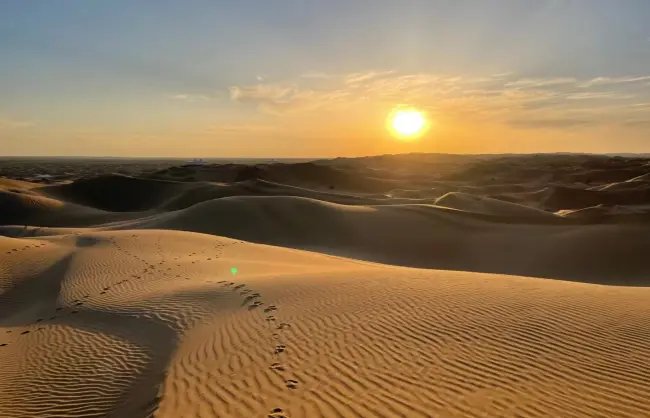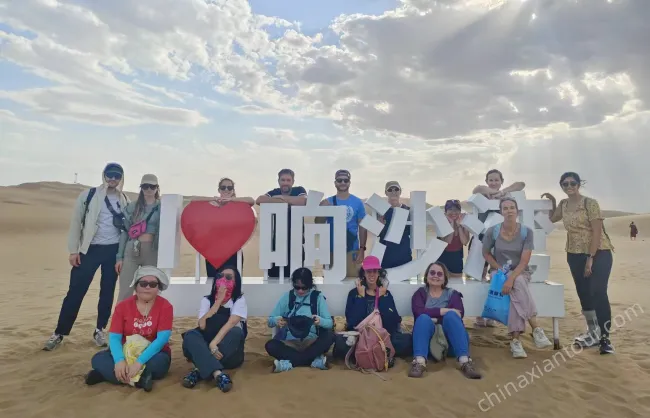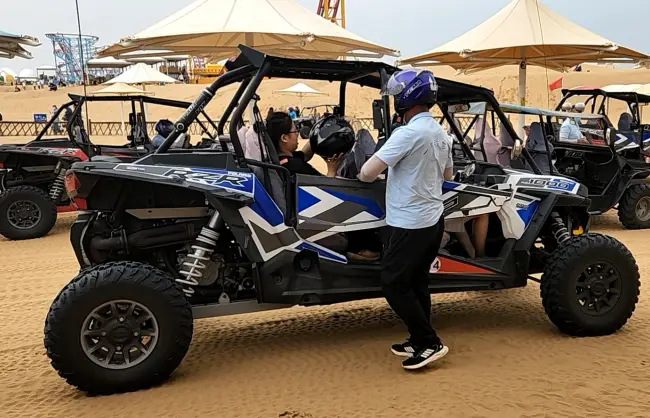As the seventh largest desert in China, the Kubuqi Desert was once renowned as the “Sea of Death”. More than 60% of dunes are mobile, and in windy weather, tons of sand can be blown to the nearby Beijing-Tianjin-Hebei region overnight.
The Kubuqi Desert offers a variety of entertainment such as desert trekking, camping, camel riding, and so on. If you have enough time, it is recommended that you arrange at least two days of your Inner Mongolia tours here in order to fully experience the charm of the desert.
Kubuqi Desert Facts
Location: North of Ordos City, Inner Mongolia Autonomous Region, China
Opening Time: From 8:00 to 18:00, stop entering the Kubuqi Desert from 17:30
Ticket Price: 30 yuan/person

Kubugi Desert Before and After
Kubuqi Desert used to be one of the most vulnerable areas in Inner Mongolia. Due to low vegetation cover and frequent sandstorms, the Kubuqi Desert has seriously affected the livelihood of local farmers. With the expansion of the desert, a large amount of sediment has invaded the Yellow River, threatening the production of herdsmen along the river.
Through the hard work of generations of Chinese, the ecological protection and restoration of the Kubuqi Desert map has achieved significant results: the amount of sediment to the Yellow River has been reduced by 80%, and the forest coverage rate has increased from 7.23% in 2000 to 18.08% in 2023; chances of sandstorms have been reduced by 90%. Not only has vegetation coverage been significantly improved, but biodiversity has also been restored.
In the future, Kubuqi Desert greening will focus on the development of solar energy, which can not only generate electricity but also prevent the movement of dunes, and reduce the evaporation of soil water. These achievements have advanced the local ecological environment, as well as demonstrated the possibility of harmonious coexistence between humans and nature.
What to See and Do in Kubuqi Desert
1. Xiangshawan (Resonant Dune Bay)
- Location: Dalat Banner, Erdos City, Inner Mongolia Autonomous Region
- Ticket Price: 120 yuan/person (combo tickets with a variety of items range from 120 to 360 yuan/person)
- Opening Time: 8:00-18:00 (no entry at 16:30)
Xiangshawan is located in the eastern end of the Kubuqi Desert, where there is not only magnificent desert scenery but also many interesting desert entertainment projects. There are two popular attractions in Xiangshawan, Xiansha Island and Yuesha Island, the former with a cultural theme and the latter with a water park theme, suitable for tourists of different ages to explore and entertain.
Here you can ride a camel, take a hot air balloon to overlook the entire desert, or take a sandboard to experience the feeling of fast sliding down the sand dunes. If you want to challenge yourself, try the desert off-road vehicle. There are many professional desert climbing teams and they will lead you to climb up to 100 meters of sand mountain to feel the sense of achievement.

2. Yemingsha (Night Singing Sand)
- Location: Hangjinqi, Ordos City, Inner Mongolia Autonomous Region
- Ticket Price: 199 yuan/person
- Opening Time: 8:00-18:00
It is famous for its unique ringing sand phenomenon. When people walk or slide on the sand, the sand will make a sound similar to the roar of an airplane. It is especially pleasant at night, so it is named Yemingsha (“night ringing sand”). Here you can experience a variety of desert amusement activities, such as camping, air gliding, desert tank, and desert zipline, to fully feel the charm of desert travel. In addition, there will also be China off-road E Desert Challenge and other large scale off-road events.
3. Qixing Lake (Seven-star Lake)
- Location: The heart of the Kubuqi Desert
- Ticket Price: 80 yuan/person
- Opening Time: 9:00-17:00 (no entry at 16:30)
Qixing Lake is a comprehensive desert tourism resort integrating tourism, theme performing arts, health care, ecological sightseeing, business exhibitions, etc. Visitors can climb sand mountains and take a Ferris wheel overlooking the desert oasis. You can also watch the large-scale theme performance show “Legend of the Desert”.
There is also the world’s most advanced sand control technology and desert science and technology museum. The lake is home to more than a dozen species of birds, including first-class protected birds in China like the gull and the white swan.

Kubuqi Desert Weather& Best Time to Visit
Kubuqi Desert is a temperate continental climate zone, with characteristics of large temperature differences between day and night, strong ultraviolet rays, heavy wind and sand, and dry climate.
Spring (May): Although spring is a stormy season, the climate has begun to warm up at this time, and the humidity of the air has increases, which is a good time to explore the Kubuqi Desert.
Summer (June): Despite the heat of the Kubuqi Desert in summer, visitors who like to challenge nature are welcome at this time, just stay hydrated and protect yourself from sunburn.
Autumn (September, October): Autumn is the mildest season in the Kubuqi Desert, with less wind and sand. You can not only avoid the heat and cold but also enjoy the beautiful sunset and sunrise scenery in the desert, which is an ideal place for photography lovers.
Winter: It is not recommended to visit the Kubuqi Desert in winter due to its cold weather.
So it is recommended to choose spring, the first half of summer, and autumn to visit the Kubuqi Desert.
How to Get to Kubuqi Desert
By Air: You can fly to Ordos Ejin Horo International Airport or Baotou Airport, then transfer to the Kubuqi Desert by bus or charter service.
By Bus: You can take a bus from Hohhot to Lateqi and then transfer to Kubuqi Desert.
By Car: The journey from Hohhot to Kubuqi Desert is about 190 kilometers and takes about two or three hours to reach.
Attractions nearby Kubuqi Desert
- Mausoleum of Genghis Khan: It is the tomb of Genghis Khan, the first Khan of the Mongol Empire, which helps a lot to the research of the history and culture of the Mongol nation and the nomads in the north of China.
- Ordos Grassland: It is not only an ideal attraction to appreciate the grassland scenery, but also a good place to get an in-depth understanding of Mongolian culture and lifestyle.
- Ordos Museum: It has more than 2,000 cultural relics, including precious Ordos bronzes, ancient human remains, etc. Visitors can immerse in the trip by using modern technology like VR virtual reality.









